Mass spectrometry has become an important
measurement tool in clinical chemistry, microbiology, toxicology and in the
pharmaceutical world. A mass spectrometer deflects ionized and accelerated
molecular fragments using a magnetic field and sorts them according to their
charge to mass ratio. For this exercise you will use
the PASCO e/m apparatus like a mass spectrometer to determine the electron's
charge to mass ratio, e/m, by measuring the radius of curvature of an electron's
path in a uniform magnetic field of known strength.
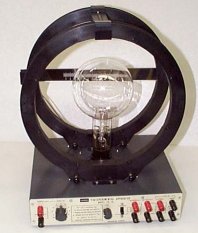 In the PASCO e/m apparatus a beam of electrons is
accelerated through a known potential difference, so the kinetic energy
and therefore the velocity of the electrons is known. A pair of
Helmholtz coils can produce a uniform magnetic field at right angles to
the electron beam. This magnetic field then deflects the electron beam
in a circular path. A unique feature of the e/m tube is that the socket
rotates, allowing the electron beam to be oriented at any angle (from
0-90 degrees) with respect to the magnetic field produced by the
Helmholtz coils. The vector nature of the magnetic force on moving
charged particles can therefore be explored. A small permanent magnet
can also be used to deflect the electron beam.
In the PASCO e/m apparatus a beam of electrons is
accelerated through a known potential difference, so the kinetic energy
and therefore the velocity of the electrons is known. A pair of
Helmholtz coils can produce a uniform magnetic field at right angles to
the electron beam. This magnetic field then deflects the electron beam
in a circular path. A unique feature of the e/m tube is that the socket
rotates, allowing the electron beam to be oriented at any angle (from
0-90 degrees) with respect to the magnetic field produced by the
Helmholtz coils. The vector nature of the magnetic force on moving
charged particles can therefore be explored. A small permanent magnet
can also be used to deflect the electron beam.
 The e/m Tube
The e/m Tube
The e/m tube is filled with helium at a pressure of 10-2
mm Hg. It contains an electron gun and deflection plates.
The electron beam leaves a visible trail in the
tube, because some of the electrons collide with helium atoms.
The atoms are excited and then radiate visible light.
 The
electron gun is shown in the figure on the right. The heater heats the cathode, which emits electrons. The
electrons are accelerated by a potential difference between the
cathode and the anode. A grid is held positive with respect to
the cathode and negative with respect to the anode. It helps to
focus the electron beam.
The
electron gun is shown in the figure on the right. The heater heats the cathode, which emits electrons. The
electrons are accelerated by a potential difference between the
cathode and the anode. A grid is held positive with respect to
the cathode and negative with respect to the anode. It helps to
focus the electron beam.
The Helmholtz Coils
The radius of the coils is equal to their separation. This geometry
provides a highly uniform magnetic field near the center of the coils. The
Helmholtz coils of the e/m apparatus have a radius and a separation of 15 cm.
Each coil has 130 turns. The magnetic field B produced by the coils is
proportional to the current I through the coils times 7.80*10-4 T/A.
It is perpendicular to the plane of the coils.
B = (7.80*10-4 T/A) * I.
The Controls
The control panel of the e/m apparatus is straightforward. All connections
are labeled.
Cloth Hood
The hood can be placed over the top of the e/m apparatus so the experiment
can be performed in a lighted room.
Mirrored Scale
A mirrored scale is attached to the back of the rear Helmholtz coil. It is
illuminated when the heater of the electron gun is powered. By lining the
electron beam up with its image in the mirrored scale, the radius of the beam
path can be measured without parallax error.
Experiment: Measuring e/m
Open a Microsoft Word document. Answer all the questions in blue font.
Power supplies and meters are connected to the to the front panel of the e/m apparatus, as shown
in the figure below.
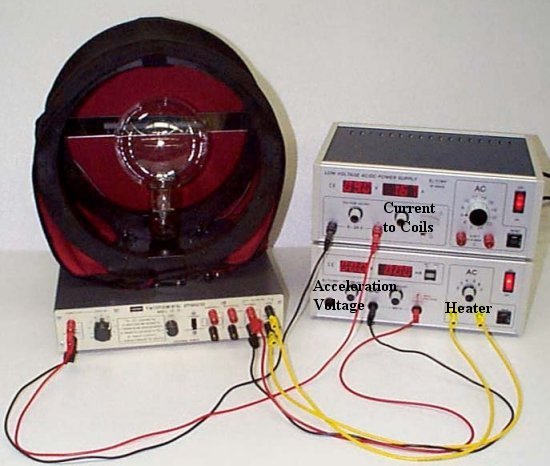
The power supplies are adjusted to the following levels:
- Electron Gun Heater Voltage: 6 VAC
- Acceleration Voltage: 150 to 300 VDC
- Helmholtz Coils Voltage: 6-9 VDC
The current for the Helmholtz coils is adjusted with the current adjust knob.
The ammeter displays the current in units of Ampere (A).
After the cathode has heated up, the electron
beam emerges from the electron gun. Its path is curved by the field from the
Helmholtz coils. The electron beam's path is parallel to the Helmholtz coils.
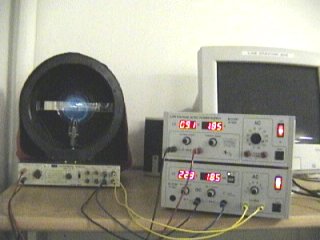
Carefully read the current to the Helmholtz coils from the ammeter
(upper power supply) and the acceleration voltage from the voltmeter (lower power supply) in the picture below.
Record the values in the table 1.
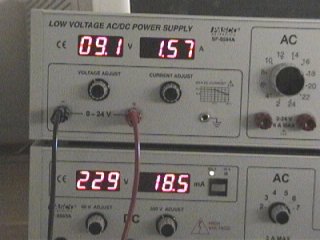
Table 1
Current
to coils
I (A) |
Accelerating
voltage
(V) |
Magnetic field B
=
(6.6*10-4T/A)*I |
Radius of
circular path
r (m) |
e/m
=
2V/(Br)2
|
| |
|
|
|
|
Carefully measure the radius of the circular path of the electron beam.
Look through the tube at the electron beam. Measure the
radius of the path as you see it on both sides of the scale, then average the results.
(The markings on the scale are in units of cm.) Record your result in the table.
Paste your table into your Word document.
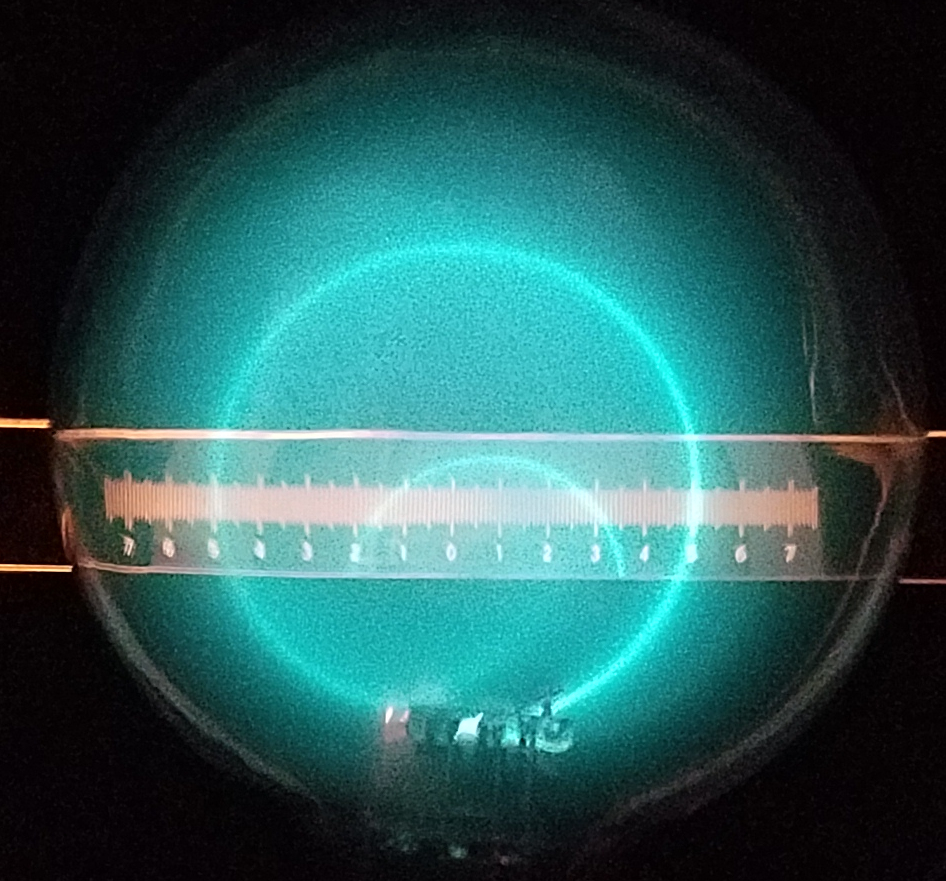
To earn extra credit add your name and e-mail address to your Word document.
Save your Word document (your name_exm7.docx), go to Canvas, Assignments,
Extra Credit 7, and submit your document.
 In the PASCO e/m apparatus a beam of electrons is
accelerated through a known potential difference, so the kinetic energy
and therefore the velocity of the electrons is known. A pair of
Helmholtz coils can produce a uniform magnetic field at right angles to
the electron beam. This magnetic field then deflects the electron beam
in a circular path. A unique feature of the e/m tube is that the socket
rotates, allowing the electron beam to be oriented at any angle (from
0-90 degrees) with respect to the magnetic field produced by the
Helmholtz coils. The vector nature of the magnetic force on moving
charged particles can therefore be explored. A small permanent magnet
can also be used to deflect the electron beam.
In the PASCO e/m apparatus a beam of electrons is
accelerated through a known potential difference, so the kinetic energy
and therefore the velocity of the electrons is known. A pair of
Helmholtz coils can produce a uniform magnetic field at right angles to
the electron beam. This magnetic field then deflects the electron beam
in a circular path. A unique feature of the e/m tube is that the socket
rotates, allowing the electron beam to be oriented at any angle (from
0-90 degrees) with respect to the magnetic field produced by the
Helmholtz coils. The vector nature of the magnetic force on moving
charged particles can therefore be explored. A small permanent magnet
can also be used to deflect the electron beam. The e/m Tube
The e/m Tube The
electron gun is shown in the figure on the right. The heater heats the cathode, which emits electrons. The
electrons are accelerated by a potential difference between the
cathode and the anode. A grid is held positive with respect to
the cathode and negative with respect to the anode. It helps to
focus the electron beam.
The
electron gun is shown in the figure on the right. The heater heats the cathode, which emits electrons. The
electrons are accelerated by a potential difference between the
cathode and the anode. A grid is held positive with respect to
the cathode and negative with respect to the anode. It helps to
focus the electron beam.


